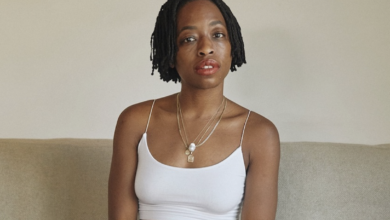A Woman’s Body Is Her Own

[ad_1]
There was a moment, about a week after our daughter was born, when all three of us were lying in bed. This was a first. We’d done so in the hospital, piled into twin beds pushed together, the tiniest, floppiest thing on one of our chests, but those few days had been a haze. Was she even real? Had I given birth? Was I alive? Was she human? Was I asleep or awake? When one of the Austrian nurses said (for we lived in Vienna), die Mama und der Papa, I looked around for my own parents.
So, the night we got home, or maybe a few after that, we found ourselves alone in our own bed, my husband and me where we’d always been, but now with her in the middle, an apt if too on-the-nose metaphor. We had no idea what to do with her. I’d had the vague notion that she’d sleep in a co-sleeper on my side, or maybe between us, but now it didn’t seem that simple to decide where to put her. Wherever she fell asleep seemed to be where she’d end up, so she was between us, wrapped up tight, oblivious, asleep for the moment. Both of us feared crushing her. I looked at my husband, who was almost as shell-shocked as I was, although not physically decimated. In a voice of the truly desperate, I whispered, Do you think we should have waited to have her?
A woman seven days postpartum is not in her right mind, and perhaps my husband recognized this and simply said, There’s no point in thinking about that now, knowing, of course, that we couldn’t return her to the place we’d retrieved her, or to the moment when we decided to try for her, or even to the day when we saw the two lines on the stick, what felt like eight lifetimes ago. But as I said, I was not totally sane and already sleep deprived and pumped full of hormones and milk and gushing blood and my C-section scar would soon be infected and I’d be put on two types of antibiotics, and something inside me thought, Well, maybe if I concentrate hard enough, I can go back in time and stall this whole process. She can disappear.
We’d been married only a year, together for two. Didn’t we want more time together? Who does this all so quickly? What had we been thinking?
It didn’t matter then. The deed was done. The proof in flesh and bone and our DNA, and my gaping belly and hardened breasts. When she cried out in the darkest part of the night, a place I’d never before been, it was my problem. But nonetheless, I tried to will us back 10 months, to the week we’d said to each other, I’m ready. I thought, Try hard enough and you can erase everything.
My point here is that this was a wanted baby. So, so wanted. I charted and timed and took my temperature and hoped and fucked my way there. I was 34 years old when I looked at the positive stick. We sobbed with happiness and relief and excitement. And yet. There she was, ours, forever — God, what a scary word, I’d never understood it before now! — and I was overcome with ambivalence and fear.
None of it lasted all that long, luckily, for me. Soon I was, strangely, just her mother, and we moved along, adjusting to this new life à trois. It wasn’t easy, but I did grow to love her and love her presence in our life. My point, of course, is that even birthing a wanted baby is a shattering; an earthquake, full of every possible feeling, including regret and uncertainty and shame and terror.
This moment came to me recently as the Supreme Court discussed the Mississippi abortion law; as women’s rights to own our bodies and reproductive choices are, once again, thrown to six justices who still cannot even glimpse the realities of living with a reproductive system. I thought about lying in that bed with this seven-day-old baby and this man I loved more than anything, and truly not wanting to keep her. To have had her under duress. To not want to be with her father. For her father to not want her. To be a teenager. To have had birth control fail. To be too ill, physically or mentally, to take care of her. Or to be forced to give her away because I knew I couldn’t provide for her, or just didn’t want to, or because I wasn’t able to abort the pregnancy when I knew that’s what I wanted and needed. How each time our reproductive rights — and thus our lives — are tossed around like some sort of worn-out hacky sack, women line up and pour our histories and hearts out, begging for understanding; trying, one story at a time, in fury and anguish, to show our patriarchal system and the men (and sometimes women!) who run it what on earth it looks like, what it feels like, to actually be a woman.
No one, least of all Brett Kavanaugh or Amy Coney Barrett, has come over to help us raise our daughter or negotiate childcare costs or responsibilities or pay for my pregnancy-induced back troubles or negotiate division of labor in my house. (Nor were they there when I was too sick to function for the first 20 weeks of the pregnancy or had gestational diabetes.) Yes, there are the occasional grandparents or babysitters or after-school programs. And for three years there was money from the Austrian government.
But does any of that matter?
What does it take to make my body truly my own? What proof do they need?
How many ways can you say: I am human, too.
I am. I am. I am.
Abigail Rasminsky is a writer, editor and teacher based in Los Angeles. She teaches creative writing at the Keck School of Medicine of USC and writes the weekly newsletter, People + Bodies. She also written for Cup of Jo about marriage, motherhood and neighbors.
You might also like to read: “The Abortion I Didn’t Have” (NYTimes) and “Why I Provide Abortions” (Boston Review). If you are able, please consider joining us in donating to Planned Parenthood, the ACLU, or local abortion funds. Says a reader named Kate: “Local abortion funds and clinics operate on a shoestring and provide the medical fees, practical/emotional support, transportation, lodging, etc. directly to people who are seeking abortion care and couldn’t otherwise afford it. This is an immediate way to assist those most impacted by abortion restrictions.” Thank you so much. xo
P.S. On sexual harassment, and five ways to teach kids about consent.
(Photo by Lucas Ottone/Stocksy.)
[ad_2]
Source link







